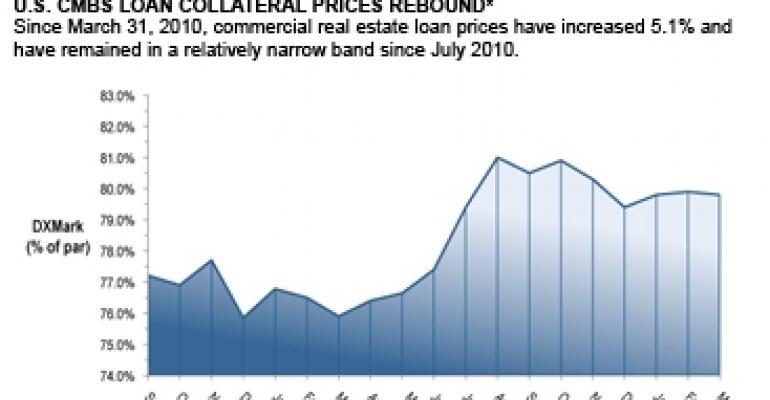The commercial real estate sector has had little to cheer about recently, but robust demand for loans is reason for cautious optimism among industry professionals.
Liquidity in the commercial real estate loan marketplace is creating at least two opportunities that will benefit the entire industry.

First, because commercial real estate loan sales are significantly strengthening lenders’ balance sheets, their ability to finance new projects is improving.
Second, commercial real estate properties that have been in legal limbo are starting to change hands as investors purchase the loans to own the property, reposition it and generate positive cash flow.
These two trends alone suggest that the commercial real estate market may be poised for a recovery.
In addition, loan prices are stabilizing due to modestly improving fundamentals in the commercial real estate market, and that is giving lenders more confidence to sell loans to strengthen their balance sheets.
The aggregate value of the more than 55,000 loans in the commercial mortgage-backed securities (CMBS) universe is off the post-crisis lows. Since March 31, 2010, commercial real estate loan prices have increased 5.1% and have remained in a relatively narrow band since July 2010 (see chart).
Lender balance sheets improve
To be clear, the underlying motivation of institutions is not solely to improve liquidity in order to originate more commercial real estate loans. A longer-term goal is at work.
Institutions that can fortify their balance sheets will be in the best position to emerge as winners in the next round of financial services consolidation.
However, in the short term the cause for optimism for real estate professionals is that commercial banks, insurance companies and other lenders are shoring up their balance sheets by actively selling commercial real estate loans.
Strong demand for all types of commercial real estate loans is helping institutions achieve their most important loan sale objective — maximizing price. Competitive bidding among an expanding base of buyers is creating a deep loan marketplace.
Institutions have taken advantage of that liquidity to sell both performing and non-performing commercial real estate loans. In selling non-performing loans, lenders are eliminating the high cost of loan workouts and real estate owned (REO) properties.
In selling performing loans, lenders are actively managing their balance sheets to minimize risk, improve diversification and pursue new lending opportunities.
Lenders have focused on disposing of acquisition, development and construction loans, which suffered the greatest losses after the collapse of the housing market.
Lenders have also been active sellers of loans collateralized by retail and industrial properties. Those, too, have been hit hard by the economic downturn.
Commercial real estate lenders have a strong incentive to act now because of an imminent refinancing wave. More than $1 trillion in commercial real estate loans will mature by 2015, and about half of those loans are underwater, according to industry observers.
Global pool of motivated buyers
The wide range of available commercial real estate product is attracting a diverse pool of investors, each of which may have a slightly different investment objective.
Opportunity funds, private equity funds and hedge funds, which typically have a higher appetite for risk, have been significant buyers of distressed loans.
More than other types of investors, distressed loan buyers are purchasing loans to own the underlying assets. These properties are often underwater or are mired in foreclosure or other legal proceedings.
Distressed loan buyers see an opportunity to purchase the commercial real estate loans at an attractive price, with the intention of repositioning the properties and generating positive cash flow again.
This investment activity is having a beneficial impact across the commercial real estate market. New capital and new management are unlocking properties that have been in a state of paralysis.
Income-oriented investors also are buying commercial real estate loans, but they are more interested in performing loans.
Despite all the attention about distressed loans, many seasoned commercial real estate loans that are performing are being sold. And there is sustained demand for that product.
Because of the current low interest rate environment, seasoned performing loans with attractive yields have been a favorite of yield-hungry investors. These loans are typically purchased at yields ranging from 5.5% to 7%, a significant premium over the 2% to 3% offered by U.S. Treasury bonds.
Banks, particularly local institutions, are active buyers and sellers of commercial real estate loans. That’s a positive for commercial real estate lending for several reasons.
First, the secondary market gives banks an outlet to sell loans and strengthen their balance sheets. Second, loan sales by smaller institutions often inject fresh capital from outside the immediate area.
Smaller lenders are actively selling commercial real estate loans with face amounts as little as $1 million. Before the Internet led to a revolution in the cost of loan sales, only loans of $50 million or more could be traded because transaction expenses were prohibitive.
Smaller loans attract more market participants and enhance liquidity. In hard-hit areas in the Southeast and West, where real estate assets have declined significantly in price, new capital from outside investors is having an uplifting effect on local real estate markets.
The good news for commercial real estate market participants is that liquidity in the loan marketplace will continue, resulting in a stimulative effect.
Between 2003 and 2008, about 25% of banks sold all types of loans, including commercial real estate loans. In 2009, that percentage jumped to 33% and has remained there ever since.
A fundamental shift is under way among loan portfolio managers that will likely lead to further liquidity — not only for commercial real estate loans but also for all loans. That’s a positive sign, particularly after the hardship of the recent past.

Kingsley Greenland is CEO of DebtX, a full-service loan sale advisor for commercial, consumer and specialty finance debt. DebtX operates the largest marketplace for loans and provides valuation and analytics services, as well as web-based deal management platforms for syndication, agency, and loan sale professionals.

